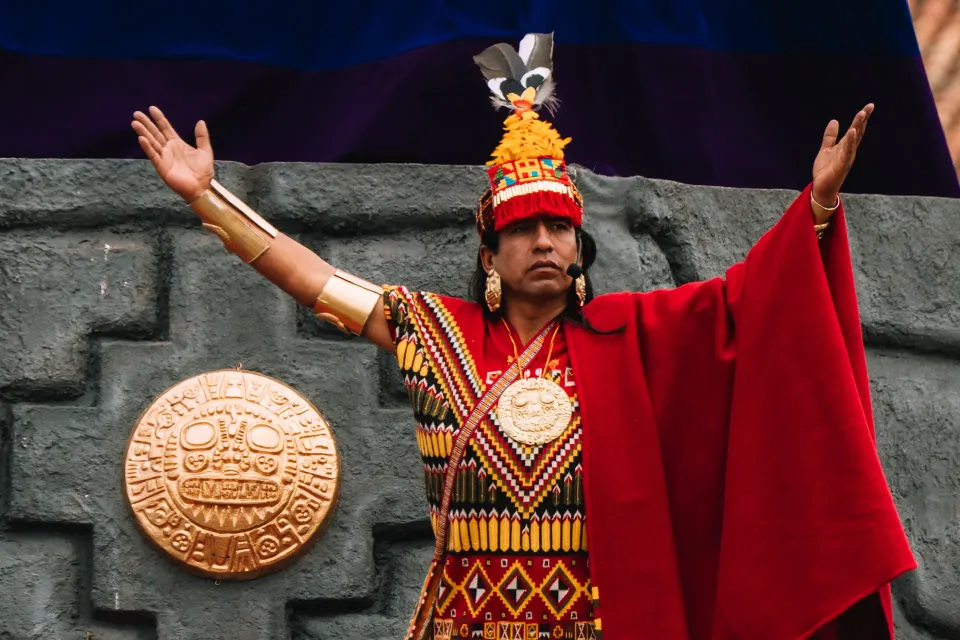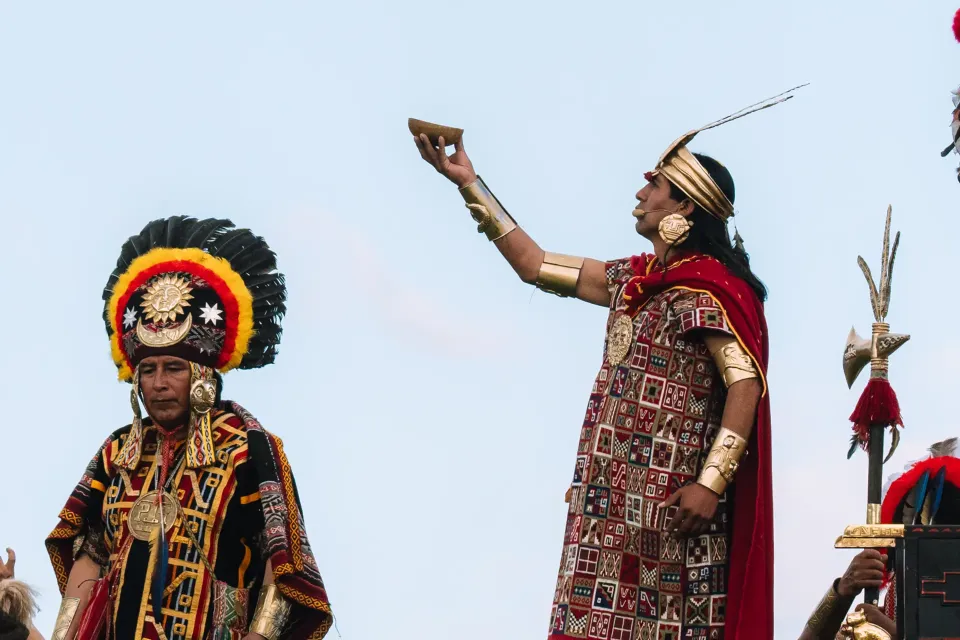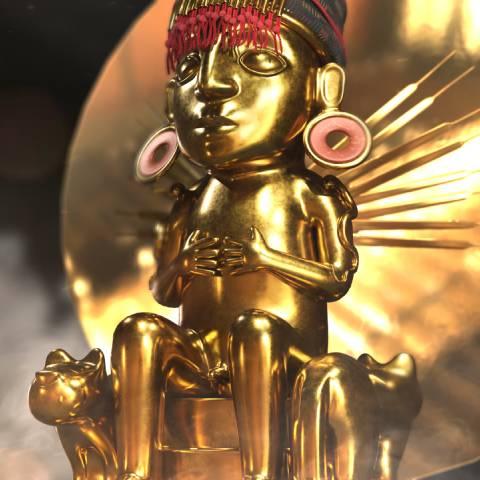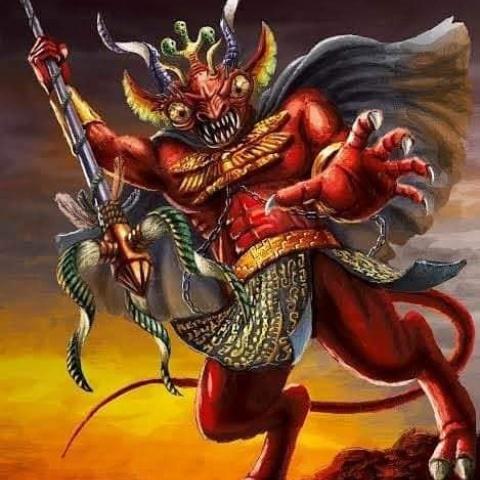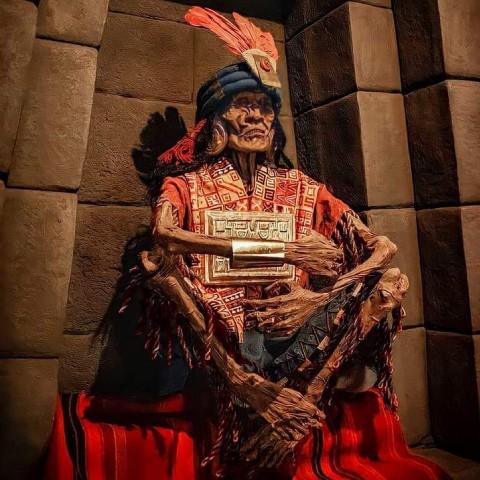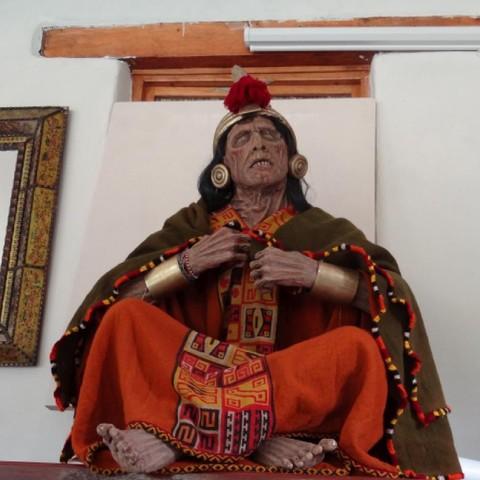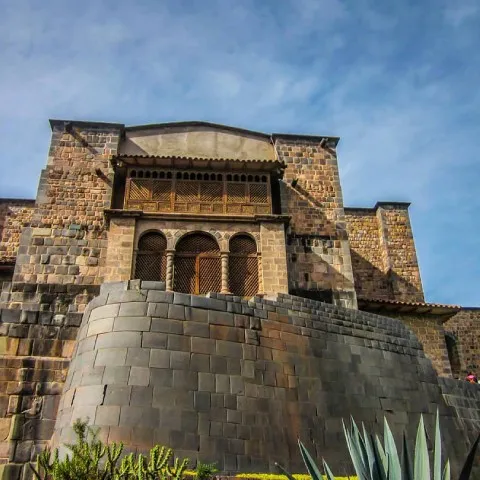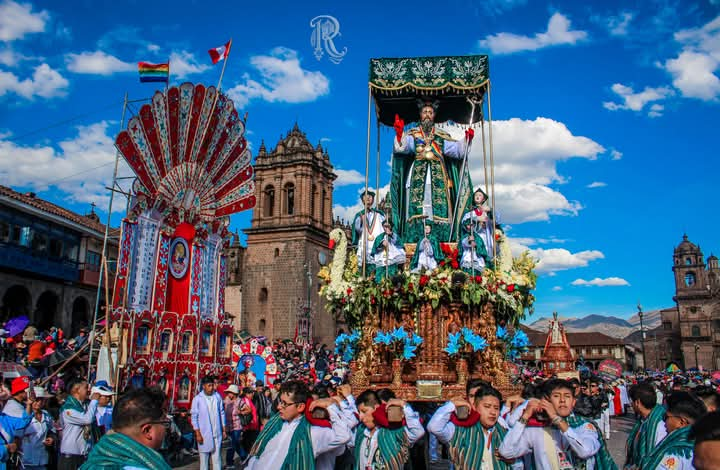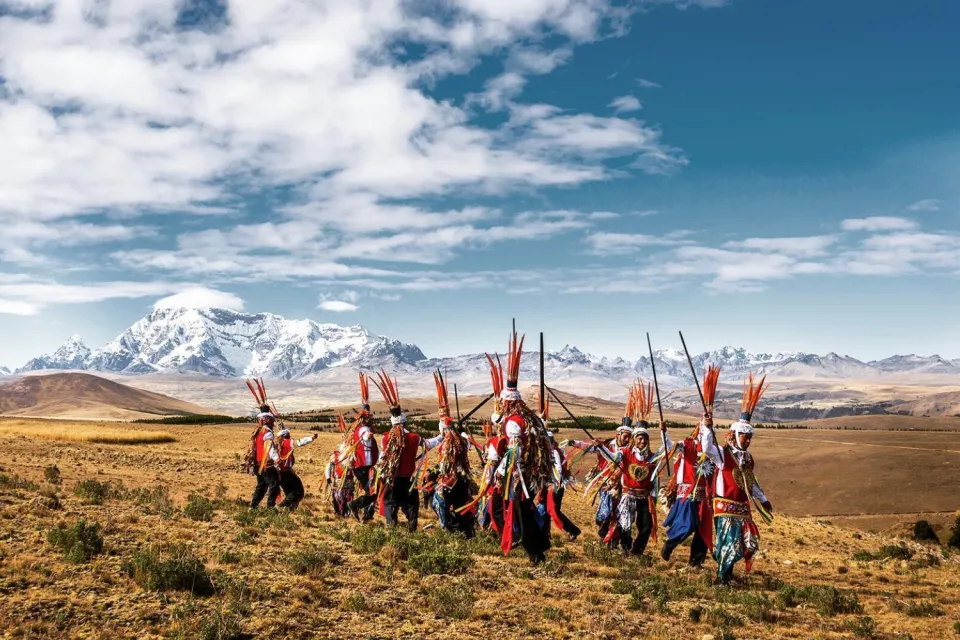What would you do if I told you that the mountains watch you and judge your every action? For the Inca Empire religion, this was not a metaphor — it was their reality.
Here, you will uncover the secrets of the Inca religion that the Spanish conquerors failed to understand.
Inca religion grew from myths and beliefs. It started before the Inca Empire and became more complex over time. You can see a clear difference between the elite’s religion and popular beliefs.
According to 16th-century chroniclers, the Inca gods formed a trio. At the top was Viracocha Pachayachachi, the creator of the world. Then came the Sun (Inti-Punchao), the Thunder (Illapa), and the Apus, sacred mountains. These gods shaped daily life through rituals, beliefs, and traditions that lasted for centuries. Gold objects often represented their supreme deity to mortals.
The History of Inca Empire Religion
The Incas believed in many gods and viewed nature as sacred. They worshiped a god who created the world, gave life, and could end it. Over time, this god took different names. You may know him as Pachacamac, Kon, or Viracocha.
Other gods and sacred animals also played a role in their religion. The Incas believed these beings had supernatural powers. Their beliefs often involved opposites that complemented and balanced each other, creating harmony.
Did you know that: The Incas treated conquered people like friends. They gave political roles to local leaders. The Incas also allowed them to keep their gods. However, they had to accept that the Inca ruler was above all their gods.
Inca Religion
The Inca religion was polytheistic, which means they believed in many gods. It was the heart of Andean culture. The Incas spread the worship of Wiracocha Pachayachachi, the creator god, to all the people they conquered. Their religion focused on nature, worshiping natural forces and beings.
The Andean worldview was divided into three worlds. The world above, the earthly world, and the world below. Two big religious ceremonies marked this belief. These events happened during the solstices. People carried figures of Inca gods and mummies of dead emperors in processions.
Main Festivals in the Inca Calendar
Inca religious festivals took place in sacred spaces. People did not focus on statues or sacred objects inside buildings. Instead, the temples were spaces marked for worship. Most of these temples were near water sources like rivers and lakes. Each Ayllu or Panaca (Inca family groups) managed the rituals.
Here are four important Inca festivals:
- Capac Raymi
This festival honored the sun during the December solstice. People carried out rituals while walking upstream along the rivers (Mayucati). - Huayna Punchao
This festival was part of the famous Inti Raymi celebration in Cusco. It honored the sun during the June solstice. Priests, known as Tarpuntaes, walked downstream following the river. They watched the sun’s position, visited sun temples, and worshiped at sacred places like Apu Huanacahuri, Catequil, Coropuna, Pariacaca, and Pachacamac. - Citua
The third festival focused on cleansing. People performed rituals to clean the Cusco valley and prepare for the new farming year. It took place in the space between the main square and the Coricancha temple. - Qolla Raymi
Tarpuntaes (Inca priests) and Acllacuna (chosen women) celebrated this festival.
Ritual Temples
The Incas built sacred temples for religious worship. Three important ones are:
This was the most sacred temple in Cusco. It was a temple for the sun god, Apu Punchao. People honored the ancestors of the Sapa Inca (the emperor) and all the main gods of the empire here.
Pachacamac
This temple was built near the sea. It honored Pachacamac, the god of earthquakes, and the sun god.
Island of the Sun
This sanctuary was located on a rocky island in Lake Titicaca. It was a sacred place dedicated to Inti, the sun god.
Male Trinity
The Incas shared their main gods with other cultures of the time. Three powerful gods ruled the world:
- The Sun (Inti)
- Illapa (God of thunder and rain)
- Viracocha-Pachacamac (Creator god)
These gods ruled three worlds:
- Kay Pacha: The visible world where humans live.
- Hanan Pacha: The invisible world where the gods moved daily.
- Hurin Pacha: The home of Viracocha-Pachacamac. His power was seen on Earth through Illapa, the thunder god.
Female Trinity
Three goddesses who represented the moon's three phases formed this trinity:
- Mama Cocha: Goddess of lakes and seas.
- Mama Quilla: Goddess of the moon.
- Pachamama: Goddess of the Earth.
Aymara Trinity
The Aymara people also had their own sacred trinity:
- Pachamama: Goddess of the Earth.
- Mallku: Spirit of the mountains.
- Amaru: Sacred serpent.
Did you know that: the Villac Umu (High Priest of the Inca religion) led the major ceremonies and rituals. In addition, 12 priests called Hatun Villac assisted him, and they were responsible for preparing ritual offerings and sacrifices.
Main Gods of Inca Empire
Punchao: The Sacred Icon of the Incas
You can think of Punchao as the most important image of Inca worship. According to legend, this god appeared in the dream of a future Inca ruler. He saw the god in the clear waters of the Susurpuquio spring, now called Inkiltambo. Once the ruler gained power, he ordered a gold figure to be made in the form of a 10-year-old boy wearing sandals and a tunic. The image was kept in the Temple of the Sun in Vilcabamba. However, after the Spanish arrived, soldiers of Martín Meneses stole it from Hualpa Yupanqui.
Inti: Sun God
Inti means "sun" in Quechua. He was seen as a servant of the creator god, Wiracocha. Inti ruled the sky and had power over humans on Earth. He was one of the most important gods of the Incas. People represented him as a golden disk. The Acllahuasi (House of the Chosen Women) was home to women who worshiped Inti. People honored him during the Inti Raymi festival and made sacrifices of llamas, gold, and sometimes humans during Capac Hucha. Over time, Inti's image changed, and he eventually merged with the god Wiracocha.
Wiracocha: The Supreme Creator
Wiracocha, also called Apu Qun Tiksi Wiraqucha, was the creator god. His name means "Lord of Water, Earth, and Fire" which shows his control over nature. He was worshiped at the Quisuar Cancha temple and is believed to have come from Tiahuanaco. The Inca ruler Pachacutec ordered his worship to be spread. During his journey to the sea, Wiracocha passed through Cacha, where locals tried to kill him. He raised his hands and made fire rain from the sky. Today, the Raqchi Temple stands in his honor.
Pachamama: Mother Earth
Pachamama means "Mother Earth" in Quechua. She represents the Earth as a provider and protector of all living things. People honored her as the goddess of fertility, life, and growth. Celebrations for Pachamama were focused on farming and livestock. Rituals included offerings of llama blood, coca leaves, seashells, and llama fetuses to ensure fertile land.
Supay: Lord of Death
Supay was the god of death and evil. He ruled the Uku Pacha (underworld) and was linked to minerals. People believed he could transform into different animals.
Apus: Protectors, Judges, and Sacred Spirits
Apus were the mountain gods. People believed Apus protected and judged human actions. These gods were linked to sacred places called Huacas, where offerings and human sacrifices were made.
Huacas: Sacred Places
Huacas were sacred sites carved into stone. People believed these places were homes for idols and spirits. They were often linked to Apus or guardian mountains. Many were near water sources like rivers and lakes, where people held ceremonies and made sacrifices of llama blood.
Cochamama: The Voice of Seas and Lakes
Cochamama was the goddess of the sea and lakes. People believed she controlled marine forces. Offerings and ceremonies were made to calm her anger.
Other Secondary Gods
Quilla: Moon Goddess
Quilla means "moon" in Quechua. She was the sister and wife of Inti, the sun god. People linked her to the feminine world. She controlled harvest times and was honored in the Coya Raymi festival in September. She was represented by a silver disk.
Coyllur: Goddess of Beauty and Stars
Coyllur, also called Chaska, was the goddess of beauty and stars. She was the sister of Illapa and the protector of maidens. Her light followed the moon's path.
Kuychi: Protector of the Inca
Kuychi was a divine being linked to Apu Huanacauri and the double-headed serpent Amaru. He was seen as a bringer of disease or death.
Illapa: God of Thunder and Rain
Illapa, also known as Chuquilla, Catuilla, and Intillapa, was the god of thunder. People believed he caused rain, hail, and storms. He was honored in the Sacsayhuaman temple, and today, he is symbolized as "Santiago Mata Indios" (Saint James the Indian Slayer).
Wasikamayuq: Protector of Homes
Wasikamayuq was the god who watched over homes and families. People believed he protected houses from harm.
Sacred Animals in the Inca Religion
Condor
The condor represented the Hanan Pacha (heavenly world). People saw it as a messenger of the gods, connecting the earthly world to the divine world.
Puma
The puma symbolized Kay Pacha (the earthly world). It was a sign of power, strength, and intelligence. The puma was also linked to political power. The layout of the city of Cusco was said to resemble the shape of a puma.
Serpent (Amaru)
The serpent represented the Uku Pacha (the underworld). It acted as a link between the earthly world and the underworld. People believed the double-headed serpent Amaru lived underground and controlled water. It also represented rainbows and chaos.
Other Sacred Animals
- Ccoa: A mystical black feline with glowing eyes. It was blamed for destructive hailstorms caused by the movement of its tail.
- Llama: A sacred animal and a key part of Inca life. It served as a form of transport and was often sacrificed during ceremonies.
Hanan Pacha, Kay Pacha and Ukhu Pacha: The Andean Cosmovision
In the Inca religion, as in many other cultures, there was a belief in the continuation of life after death.
The destiny of the soul depended on the actions and behavior during life. According to the Inca worldview, at death, the soul undertook a journey to one of the three worlds:
Hanan Pacha (the upper world).
This world was the equivalent of paradise in the Christian religion. Those who lived righteously and honestly arrived here, where they joined the god Inti or the creator god Wiracocha.
In this realm of peace and light, souls enjoyed eternal tranquility.
- Representation: The condor and fire, symbols of the sun.
Kay Pacha (the earthly or middle world)
This is the world of daily life. The Incas strived to be just and honest, as they believed that this would allow them to reach the Hanan Pacha after death.
In this world, some spirits remained close to their families, influencing their lives through rituals and offerings.
- Representation: The puma, defender of this world.
- Key elements: Mountains, stones and hills.
Ukhu Pacha (the underworld or world below)
In this realm, souls purified themselves and reflected. Those who had not been virtuous or who had died unexpectedly came to this place. To leave, souls had to face challenges and trials.
- Representation: The two-headed serpent, called Amaru.
- Key elements: Marine animals, sea waves, waterfalls.
The Andean Cross (The Chakana)
The chakana, or Andean cross, represents the integral vision of the three worlds. It is a symbol that organizes and connects Hanan Pacha, Kay Pacha and Ukhu Pacha, encompassing the fundamental principles of the Andean cosmovision.
Ancestor Worship and Mummies
The Incas practiced ancestor worship, especially for those of high status. They mummified these individuals and preserved them in shrines. During special ceremonies, people exhibited and venerated the mummies.
The Incas believed that the ancestors, being so close to the gods, acted as intermediaries between the world of the living and the divine world.
People performed regular rituals for them, offering food and drink to keep the ancestors happy and favorable toward the living.
Preparation for the Afterlife
The Incas believed that life after death was as significant as earthly life, so they meticulously prepared the deceased for their journey to the afterlife.
People usually buried the dead with objects they considered essential for their journey, such as pottery, tools, and food.
These objects would help them in their transit through the different worlds, facilitating their arrival at the Hanan Pacha or their purification in the Ukhu Pacha.
Inca nobles, in particular, made more elaborate preparations, as they wanted to ensure that their soul would have a place in the Hanan Pacha, the upper world, or at least that their journey through the Ukhu Pacha would be as easy as possible.
These rituals included offerings of high value, such as fine textiles, jewelry and other objects that reflected their status and wealth.
In addition, people gave them adequate spiritual and physical preparation so they could face the challenges of the underworld, if their soul had to pass through it.
Sacrifices
In order to please their deities, the Incas performed various sacrifices, especially of animals considered sacred.
One of the most important was the pillco llama, a white-furred llama used in the solar cult. Priests dressed this llama in red attire and decorated it with feathers for ceremonies.
Before the sacrifice, they adorned it with fine textiles and accompanied it with coca leaves, chicha, and flowers.
In most cases, the Incas preferred to sacrifice male specimens; if they chose a female, she had to be sterile.
Priests could perform sacrifices at any time of the year, either to avoid misfortunes, prevent tragedies, or celebrate important festivities.
One example is the Citua ceremony, which the Incas celebrated in September to ward off diseases.
During this ritual, they slaughtered camelids and threw their remains into the river along with coca, textiles, and other ritual elements.
They also used the leftover blood from the llamas to prepare corn dumplings, which they then distributed among those present.
In addition, leftover blood from the llamas was used to prepare corn dumplings, which were then distributed among those present.
Today, during the celebration of Inti Raymi in Cusco, performers symbolically reenact the sacrifice of a llama as part of this ancient Inca festival.
Although no real sacrifice is performed anymore, visitors can still witness the ceremony as a living expression of the Tawantinsuyo’s religious legacy.
Feasts
People in the Inca Empire celebrated some festivals regionally and others throughout the entire territory.
The Sapa Inca himself led the most important celebrations in Cusco, while in other regions, Inca representatives directed the local ceremonies.
These festivities followed the Inca calendar, which consisted of 12 months of 30 days.
Each month had its own festival. At the end of the year, the Incas organized a great five-day celebration to welcome the new Andean year.
| Gregorian Month | Inca Month | Celebration |
| January | Samay killa | Small Growing Month |
| February | Hatun Puquy Killa | Great Maturation |
| March | Pacha Puquy Killa | Ripening of the land |
| April | Ayriway Killa | Month of the twin ears of wheat |
| May | Aymuray Killa | Harvest Month |
| June | Inti Raymi | Feast of the Sun and the great festival in honor of the Sun for the harvest |
| July | Chawarway Killa | Harvest Festival |
| August | Yapuy Killa | Sowing Month |
| September | Quya Raymi Killa | Festival of the Moon |
| October | Uma Raymi Killa | Month of crop observation |
| November | Aya Marcay Killa | Festival of the Dead |
| December | Qhapaq Inti Raymi | Royal Feast of the Sun, fasting and penance |
Representatives of the Inca religion
In the Inca religion, as in many others, there were representatives in charge of maintaining the link between the human and divine worlds.
These representatives were mainly the priests, who followed a well-defined hierarchical structure that organized their functions within the Empire.
The Chief Priest: Willaq Umu (or Villac Umu)
The Willaq Umu was the highest religious authority in the Inca Empire and was responsible for directing the most important rituals, especially those dedicated to the Sun God, Inti. He was considered the intermediary between the gods and humans.
In addition to his ceremonial role, he fulfilled political and spiritual functions: he served as advisor to the Sapa Inca and had the power to crown the auqui, the crown prince.
Because of their great wisdom, many Willaq Umu were brothers or uncles of the Inca himself.
When a Sapa Inca died, a new Willaq Umu was appointed.
These priests also observed the movements of the stars to decide the dates of festivities and appointed the Hatun Villca, priests of lower rank.
They lived on rents assigned by the provinces, although they only used what was necessary, allocating the rest to help the neediest. His death was so significant that a day of mourning was declared in the empire.
Some historians affirm that they led a life of abstinence: they did not eat meat, only herbs, roots and corn bread, and could not marry.
The common priest: Hatun Villca
The Hatun Villca were a network of local priests in charge of temples and huacas in each region. They performed daily rituals, offerings, sacrifices -especially of white llamas in honor of the Sun- and organized religious festivities.
They were also in charge of hearing confessions, practicing divination and offering spiritual guidance to the community.
Other Priests: Humus or Nacac
Under the Hatun Villca, there were priests of lower hierarchy who exercised their function temporarily. The Incas referred to them as humus or nacac, and they collaborated in minor rituals and community ceremonies.
The Virgins of the Sun: Acllas
Together with the priests, the Acllas played a fundamental role in the Inca religion. They selected these young women from childhood for their beauty and purity, and brought them to live in the Acllahuasi, special training centers.
There, instructors trained them to serve the solar cult: they wove sacred cloaks, brewed chicha for rituals, and, in some cases, leaders chose them as human offerings for highly important ceremonies.
However, not all Acllas served religious purposes—some became wives of the Inca or companions of important nobles.
Inca moral code
The Incas followed a simple but deeply rooted moral code based on three fundamental principles:
- Ama Sua (Do not steal)
- Ama Llulla (Do not lie)
- Ama Quella (Do not be lazy)
These three rules not only guided coexistence in society, but also determined the destiny of the soul after death.
People believed that those who complied with this code could access the Hanan Pacha, the upper world, while those who broke it would face punishment in the Ukhu Pacha, the underworld.
Furthermore, living according to these rules allowed the Incas to maintain harmony with the gods, honor their ancestors and respect nature, fundamental pillars of their worldview.
Religious Syncretism: The fusion of Inca and Catholic beliefs
The arrival of the Spanish represented a profound change, as they sought to impose, replace and eradicate the Inca religion in order to establish the Christian religion.
A massive effort was made to prevent the Incas from continuing what the Spaniards considered idolatrous sins.
However, they did not succeed in completely eliminating their beliefs, and a fusion of Christian and Inca practices known as religious syncretism emerged.
Confiscation of royal mummies
The Spanish official Polo de Ondegardo, in his eagerness to stop ancestor worship, confiscated the royal Inca mummies.
Garcilaso de la Vega relates that he visited Ondegardo's house and saw the embalmed Inca kings in an excellent state of preservation. None of them had lost hair or eyelashes, and they still had their royal diadems.
Later, they took these mummies to Lima, and although they led the people to believe that they buried them, they actually kept them in the San Andres Hospital, a hospital exclusively for Spanish residents, to which the natives had no access
Mix of traditions
Churches over sacred temples
In Cusco, the Spanish destroyed many Inca temples or reused them as a base for building Christian churches.
An iconic example of this cultural overlap is the Coricancha, an ancient temple dedicated to the Sun, on which they built the convent of Santo Domingo.
Saints and ancestors
The Incas began to associate their deities and ancestors with Christian figures.
For example, the Pachamama was equated with the Virgin Mary, which allowed the inhabitants to maintain their traditions under the guise of Christian devotion.
Adapted festivities
Inca festivities were also adapted to the Christian calendar.
For example, the Inti Raymi, ceremony to the Sun God in the winter solstice, was adjusted to coincide with the festivity of San Juan Bautista.
In more distant villages, the worship of the Sun lost strength, and the Moon began to occupy a more relevant place in the religious imaginary.
At present
Religious syncretism is still alive and more present than ever in Andean regions such as Cusco. Traditions have been strongly maintained through celebrations that combine the Catholic and the Andean.
Corpus Christi
In this festivity, there is a great parade with virgins and saints, accompanied by music and traditional dances. This celebration has its roots in the ancient veneration of Inca mummies.
Lord of Qoyllur'iti
One of the most important pilgrimages in the Andean world. Thousands of the faithful walk to the sacred mountains in search of blessings from the apus (mountain spirits) and the saint. The celebration is marked by rituals, dances and offerings.
Payments to the earth
In many Andean communities, ancestral rituals are still performed to honor the Pachamama. These offerings or “despachos” include coca leaves, chicha, flowers and food.
Andean healing practices
Healers still combine Catholic prayers with invocations to the Inca gods, using ancestral methods of healing.
Syncretic altars
In many homes in the Peruvian Andes, family altars contain Christian symbols alongside Andean elements, such as Andean crosses and figures of the Virgin.
Don't be surprised if when visiting high Andean communities in Peru, you see some people pour a little drink on the ground before consuming it. This gesture is a symbolic offering to “quench the thirst of Pachamama” and ask for her blessing.
Peruvian gods: Gods and cultures before the Incas
Chavín Culture
The Chavín culture thrived from 1500 to 550 BCE and worshiped multiple gods. Their main deity was Wiracocha, accompanied by sacred animals like hawks, condors, eagles, monkeys, snakes, spiders, and bats. You can see these depictions on the Monolithic Lanzón, a key religious artifact.
Gods of the Day:
- Eagle God: Ritual races honored this god, and winners sacrificed their blood.
- Marine Twin God: Devotees offered marine animal blood, such as sea lions.
Gods of the Night:
- Owl God: Worshipers sacrificed prisoners’ blood, seashells, and coca leaves to honor this god, linked to plant growth.
- Jaguar God: The Chavín's main deity evolved from a terrifying animal form to a human-like figure with large fangs. Human sacrifices were common in its worship.
Lima Culture
The Lima culture existed between 100 and 650 CE, centering its religious practices in Pachacamac. They worshiped Pachacamac, the god of the underworld and earthquakes. Over time, he became known as the “Lord of Tremors.”
Secondary Gods:
- Urpai Huachaq: Goddess of the sea and creator of fish, married to Pachacamac.
- Guamancanfac: Goddess of the islands, who received fish and bird offerings for guano.
Paracas and Nasca Cultures
In the Ica region, these cultures revered Kon, also known as the “Eyed God,” a creator of the earth, animals, and rivers. Kon was later overthrown by Pachacamac, who destroyed Kon’s creations.
- God Botto: A fearsome deity, Botto had a mix of marine, bird, and feline traits. People made sacrifices to appease this destructive god.
Moche Culture
The Moche people, based in La Libertad, worshiped Aiapaec, a deity with a human form and tiger-like mouth. They conducted human sacrifices to honor him. Moche rituals also paid homage to the moon, sun, and sea.
Key Deities:
- Aiapaec: Known by many names, this god symbolized maize, felines, and the air.
- Chicopaec: Associated with the sea, often guarded by warrior gods and priests.
Wari Culture
The Wari, from Ayacucho, claimed to be children of the sun. They worshiped the “Staff God” or Wiracocha, inherited from the Chavín culture. This god controlled natural forces, often taking the form of a serpent or air.
- Other Worshiped Elements: The Wari also honored fire and the sun in their ceremonies.
Tiahuanaco Culture
Located in modern Bolivia, the Tiahuanaco people worshiped Wiracocha, a creator god who emerged from Lake Titicaca to shape the world.
Key Symbols:
- Monoliths and Sun Gate: These artifacts depict Wiracocha with a solar crown and scepters, surrounded by soldiers and birds.
- Chachapuma God: A feline with a human body, this god received human sacrifices to ensure fertility.
Frequently Asked Questions
- Was the Inca religion monotheistic or polytheistic?
The Incas worshipped multiple gods, so they practiced a polytheistic religion.
They believed that their deities had the power to control and prevent natural phenomena such as rain, sun, earthquakes, floods and droughts.
They also believed that their gods could help them win battles.
- Were there oracles in the Inca religion?
Yes, oracles were an important part of the Inca religion, although their use was more focused on practical than spiritual functions.
They were mainly used to diagnose illnesses, predict the outcome of battles, discover crimes and even to determine what type of sacrifice should be offered to a deity.
This information comes from colonial chronicles. One chronicler, for example, described an oracle located in a huaca near the Huaca-Chaca bridge over the Apurimac River.
Another of the best known oracles was located in the ceremonial complex of Pachacamac, very close to the present-day city of Lima.
- How did divination take place in the Inca oracles?
The Incas practiced divination through various ritual methods. One of them consisted of observing the movement of spiders, especially their snaking, while the priests or diviners consumed coca leaves placed in a shallow dish.
This combination allowed them to “read” messages from the gods or the spirit world.
Another common method was the consumption of ayahuasca, a psychedelic drink made from Amazonian plants. This substance altered the central nervous system and produced visions that priests interpreted as divine revelations or signs of destiny.
- Does Cusco’s Corpus Christi originate from the worship of mummies?
Cusco’s Corpus Christi is the result of a fusion between Andean and Christian traditions. During the Inca Empire, it was common for people to carry the mummies of their most important Sapa Incas in processions to worship them in the main square of Cusco.
With the arrival of the Spanish and their attempt to eradicate the Inca religion, these practices were replaced by Catholic processions.
Instead of mummies, images of saints and virgins began to parade through the same streets. This strategy of syncretism was largely successful, as it managed to replace Inca religious symbols with Christian figures without entirely erasing the deeper meaning for the local population.
In fact, it is said that underneath one of the images currently carried during the Corpus Christi procession lies a hidden Inca mummy—reflecting the symbolic continuity of ancient beliefs beneath the newly imposed faith.
- How did the Incas worship their gods?
The Incas worshipped their gods by building temples and sacred places known as huacas. In these spaces, they performed special ceremonies that included prayers, chants, and dances.
During these ceremonies, they also made offerings such as food, textiles, gold objects, and, at times, animal or even human sacrifices.
All of this was meant to honor their deities and ensure their protection against natural phenomena like rain, earthquakes, or droughts.
- Did they perform human sacrifices?
Yes, the Incas performed human sacrifices on special occasions—especially after military victories or during extraordinary events such as droughts, solar eclipses, or the death of a ruler.
These sacrifices took place in sacred sanctuaries, such as mountain peaks, which were considered places of connection with the gods. A well-known example is the Children of Llullaillaco.
Most of the victims were carefully selected children from common families or the nobility. Before the sacrifice, they were given coca leaves to chew and chicha de jora (a fermented corn drink) to sedate them.
Then, they were struck on the head until death, after which their bodies were mummified and buried as sacred offerings.

